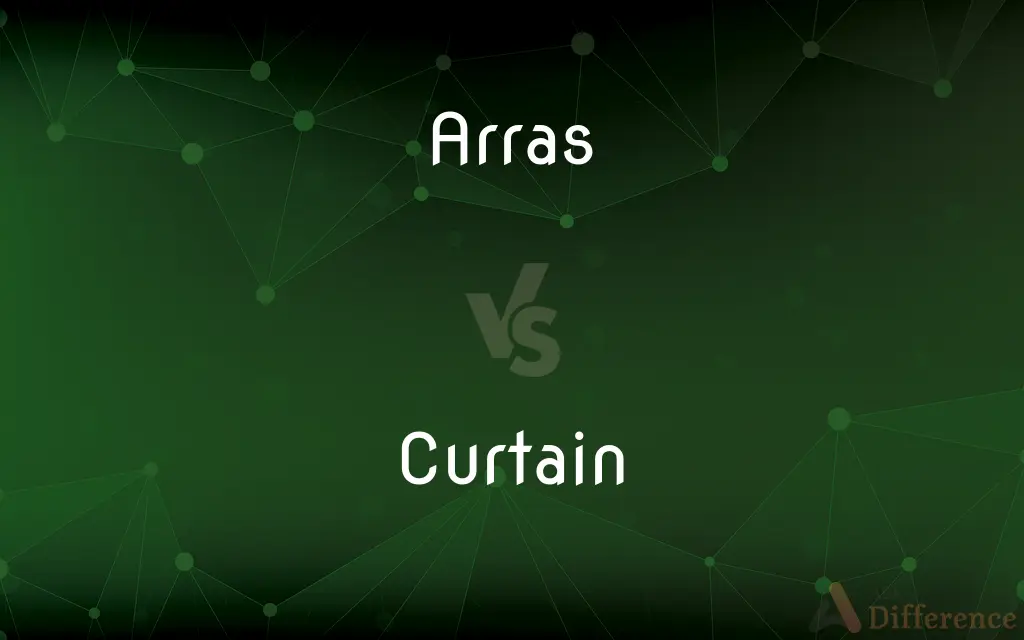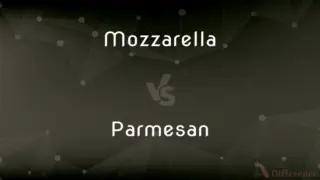Arras vs. Curtain — What's the Difference?
By Fiza Rafique & Urooj Arif — Updated on March 25, 2024
An arras is a rich tapestry hung on walls for insulation or decoration, often depicting intricate scenes, while a curtain is a piece of fabric used to cover windows, divide rooms, or block light.

Difference Between Arras and Curtain
Table of Contents
ADVERTISEMENT
Key Differences
Arrases are traditionally used for their aesthetic and functional value in adding warmth and acoustic insulation to rooms. They are crafted with detailed designs, often historical or mythological scenes, making them significant decorative elements in castles and churches. Whereas, curtains serve a more practical purpose in controlling light, ensuring privacy, and sometimes adding a decorative touch to interiors. They are made from a variety of materials, including lightweight cotton or heavy velvet, depending on their intended use.
While both arrases and curtains can enhance the interior décor, arrases are primarily valued for their artistry and craftsmanship. They are considered works of art and historical artifacts, reflecting the cultural and artistic endeavors of their time. On the other hand, curtains are an essential element of home furnishing, available in numerous styles, colors, and patterns to complement interior design themes.
The production of arrases involves intricate weaving techniques, often requiring months or years to complete a single piece. This labor-intensive process contributes to their rarity and value. Conversely, curtains are more widely available and can be mass-produced, making them an accessible option for window treatments and room dividers in various settings.
Arrases, due to their historical significance and complexity, are often found in museums, historical buildings, or as part of private collections. They tell stories and capture moments in history, serving as both insulation and decoration. Curtains, while they can be aesthetically pleasing and functional, do not typically carry the same historical or artistic weight.
In modern usage, the term "arras" is less common, and such tapestries are usually referred to as part of a broader category of historical textiles. Meanwhile, curtains continue to be a ubiquitous part of home and commercial spaces, evolving in design and function to meet contemporary needs and preferences.
ADVERTISEMENT
Comparison Chart
Primary Use
Wall decoration and insulation
Window covering, room divider
Material
Woven tapestry, often of wool and silk
Various fabrics, including cotton, silk, and polyester
Design
Intricate scenes and patterns
Wide range of colors, patterns, and transparency levels
Historical Significance
High, with cultural and artistic value
Lower, mainly functional with some decorative value
Production
Time-consuming and labor-intensive
Can be mass-produced or custom-made
Function
Adds warmth and acoustic insulation
Controls light, ensures privacy, adds aesthetic value
Location
Historical buildings, museums, private collections
Homes, offices, commercial spaces
Compare with Definitions
Arras
Symbol of wealth and status in historical contexts.
The arras in the king's chamber illustrated his conquests.
Curtain
Essential for both functionality and interior design.
Choosing the right curtains was key to the room's color scheme.
Arras
Heavy textile used for insulation and decoration.
An arras warmed the stone walls, muffling the sounds from outside.
Curtain
Used as a room divider or decoration.
Curtains separated the living area from the kitchen in the open-plan apartment.
Arras
Artistic wall hanging with historical scenes.
The museum displayed an arras from the Renaissance period.
Curtain
Can be easily changed to update a room's appearance.
She replaced the old curtains with bright, floral patterns for a fresh look.
Arras
A decorative woven tapestry hung on walls.
The castle's dining hall was adorned with an arras depicting the Battle of Hastings.
Curtain
Fabric hung over windows to block light or provide privacy.
She drew the curtains to block the afternoon sun.
Arras
A piece of art and history, often telling a story.
Each arras in the collection tells a different story from mythology.
Curtain
Available in various materials and designs.
The velvet curtains added a touch of luxury to the room.
Arras
Arras ( ARR-əss, French: [aʁɑs] (listen); Picard: Aro; Historical Dutch: Atrecht [ˈaːtrɛxt] (listen)) is the capital (chef-lieu/préfecture) of the Pas-de-Calais department, which forms part of the region of Hauts-de-France; prior to the reorganization of 2014 it was located in Nord-Pas-de-Calais. The historic centre of the Artois region, with a Baroque town square, Arras is located in Northern France at the confluence of the Scarpe river and the Crinchon River.The Arras plain lies on a large chalk plateau bordered on the north by the Marqueffles fault, on the southwest by the Artois and Ternois hills, and on the south by the slopes of Beaufort-Blavincourt.
Curtain
A curtain is a piece of cloth intended to block or obscure light, air drafts, or (in the case of a shower curtain) water. A curtain is also the movable screen or drape in a theater that separates the stage from the auditorium or that serves as a backdrop/background.Curtains are often hung on the inside of a building's windows to block the passage of light.
Arras
A tapestry, wall hanging, or curtain, especially one of Flemish origin.
Curtain
A piece of fabric or other material that hangs in a window or open space as a decoration, shade, screen, or divider.
Arras
A tapestry or wall hanging.
Curtain
Something that functions as or resembles a screen, cover, divider, or barrier
The curtain of mist before the mountain.
A heavy curtain of artillery fire.
Arras
Tapestry; a rich figured fabric; especially, a screen or hangings of heavy cloth with interwoven figures.
Stateliest couches, with rich arras spread.
Behind the arras I'll convey myself.
Curtain
The movable screen or drape in a theater or hall that separates the stage from the auditorium or that serves as a backdrop.
Arras
To furnish with an arras.
Curtain
The rising or opening of a theater curtain at the beginning of a performance or act.
Arras
A wall hanging of heavy handwoven fabric with pictorial designs
Curtain
The time at which a theatrical performance begins or is scheduled to begin.
Curtain
The fall or closing of a theater curtain at the end of a performance or act.
Curtain
The part of a rampart or parapet connecting two bastions or gates.
Curtain
(Architecture) A curtain wall.
Curtain
The end.
Curtain
To provide (something) with a curtain or curtains.
Curtain
To close off (something) with a curtain or curtains.
Curtain
A piece of cloth covering a window, bed, etc. to offer privacy and keep out light.
Curtain
A similar piece of cloth that separates the audience and the stage in a theater.
Curtain
The beginning of a show; the moment the curtain rises.
He took so long to shave his head that we arrived 45 minutes after curtain and were denied late entry.
Curtain
(architecture) That part of a wall of a building which is between two pavilions, towers, etc.
Curtain
A flag; an ensign.
Curtain
To cover (a window) with a curtain; to hang curtains.
Curtain
(figuratively) To hide, cover or separate as if by a curtain.
Curtain
A hanging screen intended to darken or conceal, and admitting of being drawn back or up, and reclosed at pleasure; esp., drapery of cloth or lace hanging round a bed or at a window; in theaters, and like places, a movable screen for concealing the stage.
Curtain
That part of the rampart and parapet which is between two bastions or two gates. See Illustrations of Ravelin and Bastion.
Curtain
That part of a wall of a building which is between two pavilions, towers, etc.
Curtain
A flag; an ensign; - in contempt.
A curtain lecture is worth all the sermons in the world for teaching the virtues of patience and long-suffering.
Curtain
To inclose as with curtains; to furnish with curtains.
So when the sun in bedCurtained with cloudy red.
Curtain
Hanging cloth used as a blind (especially for a window)
Curtain
Any barrier to communication or vision;
A curtain of secrecy
A curtain of trees
Curtain
Provide with drapery;
Curtain the bedrooms
Common Curiosities
What is the purpose of a curtain?
Curtains are used to cover windows, control light, ensure privacy, and sometimes serve as room dividers or decorative elements.
Why are arrases considered historical artifacts?
Arrases are seen as historical artifacts due to their intricate craftsmanship, depiction of historical or mythological scenes, and use in significant historical contexts.
Can arrases and curtains both serve as room decorations?
Yes, both can enhance room decor, but arrases are valued for their artistry and historical significance, whereas curtains are more versatile in style and function.
What is an arras?
An arras is a richly woven tapestry, often used in historical settings for wall decoration and insulation.
Can the design of an arras tell a story?
Yes, many arrases depict historical events, mythological stories, or emblematic scenes, serving as a narrative medium.
Are curtains only used for windows?
No, curtains can also be used as room dividers, shower curtains, or for theatrical purposes, offering versatility beyond window covering.
What factors influence the choice of curtains in a room?
Factors include light control needs, privacy, aesthetic preferences, and the room’s overall design theme.
How do arrases differ from curtains in terms of material?
Arrases are made from heavy, intricately woven textiles, while curtains can be made from a variety of fabrics, including lightweight and translucent materials.
How are arrases preserved?
Arrases require careful preservation due to their age and the delicacy of their materials, often involving controlled environmental conditions in museums or private collections.
Is it common to find arrases in modern homes?
While less common in everyday use, arrases might be found as decorative pieces in homes that favor historical or luxurious interiors.
Share Your Discovery

Previous Comparison
Backplane vs. Motherboard
Next Comparison
Mozzarella vs. ParmesanAuthor Spotlight
Written by
Fiza RafiqueFiza Rafique is a skilled content writer at AskDifference.com, where she meticulously refines and enhances written pieces. Drawing from her vast editorial expertise, Fiza ensures clarity, accuracy, and precision in every article. Passionate about language, she continually seeks to elevate the quality of content for readers worldwide.
Co-written by
Urooj ArifUrooj is a skilled content writer at Ask Difference, known for her exceptional ability to simplify complex topics into engaging and informative content. With a passion for research and a flair for clear, concise writing, she consistently delivers articles that resonate with our diverse audience.
















































